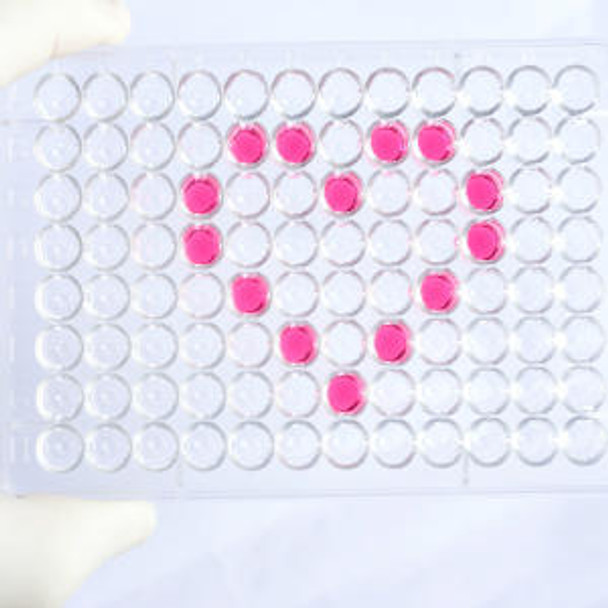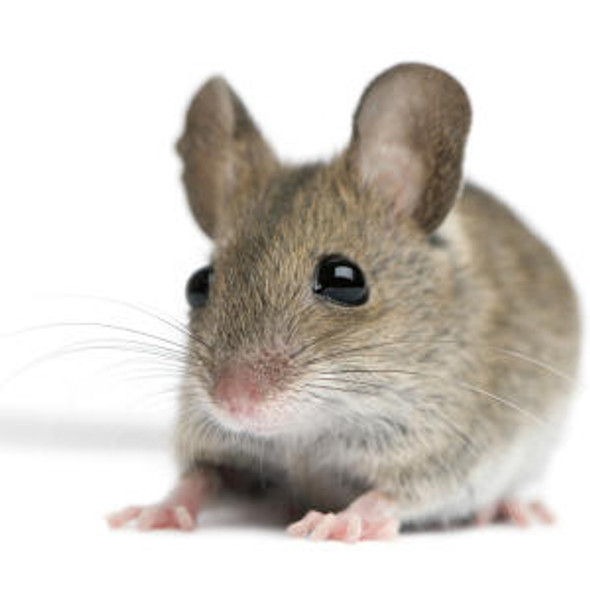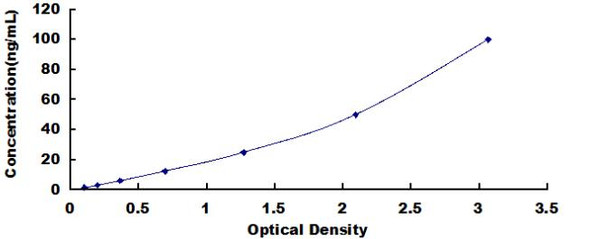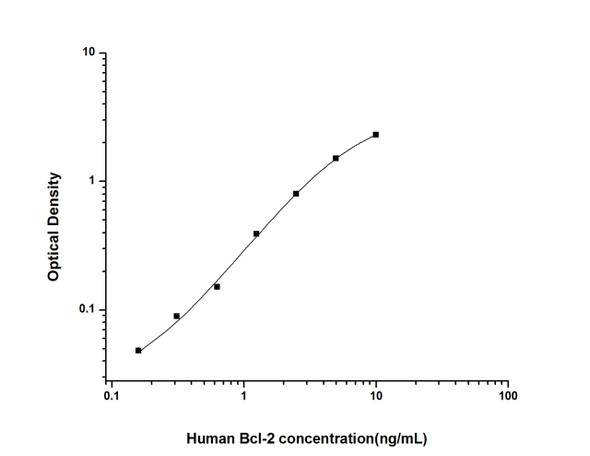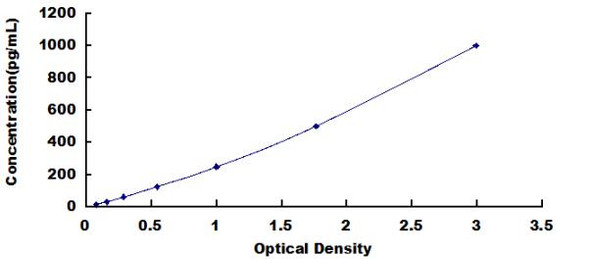Human B-cell lymphoma/leukemia 11A (BCL11A) ELISA Kit (HUEB0365)
- SKU:
- HUEB0365
- Product Type:
- ELISA Kit
- Size:
- 96 Assays
- Uniprot:
- Q9H165
- Range:
- 0.312-20 ng/mL
- ELISA Type:
- Sandwich
- Reactivity:
- Human
Description
Human B-cell lymphoma/leukemia 11A (BCL11A) ELISA Kit
The Human B-Cell Lymphoma Leukemia (BCL11A) ELISA Kit is specifically designed for the precise measurement of BCL11A levels in human samples such as serum, plasma, and cell culture supernatants. With its superior sensitivity and specificity, this kit delivers accurate and consistent results, making it an invaluable tool for various research applications.BCL11A is a critical protein implicated in the development and progression of B-cell lymphoma and leukemia.
Its dysregulation has been associated with these malignancies, highlighting its importance as a biomarker for studying these diseases and exploring potential therapeutic interventions.Trust the Human B-Cell Lymphoma Leukemia (BCL11A) ELISA Kit to provide you with reliable data for your research needs, advancing our understanding of these hematologic malignancies and guiding the development of new treatment strategies.
| Product Name: | Human B-cell lymphoma/leukemia 11A (BCL11A) ELISA Kit |
| SKU: | HUEB0365 |
| Size: | 96T |
| Target: | Human B-cell lymphoma/leukemia 11A (BCL11A) |
| Synonyms: | B-cell CLL/lymphoma 11A, COUP-TF-interacting protein 1, Ecotropic viral integration site 9 protein homolog, Zinc finger protein 856, EVI-9, BCL-11A, CTIP1, EVI9, KIAA1809, ZNF856 |
| Assay Type: | Sandwich |
| Detection Method: | ELISA |
| Reactivity: | Human |
| Detection Range: | 0.312-20ng/mL |
| Sensitivity: | 0.17ng/mL |
| Intra CV: | 7.0% | ||||||||||||||||||||
| Inter CV: | 8.3% | ||||||||||||||||||||
| Linearity: |
| ||||||||||||||||||||
| Recovery: |
| ||||||||||||||||||||
| Function: | Transcription factor associated with the BAF SWI/SNF chromatin remodeling complex (By similarity). Repressor of fetal hemoglobin (HbF) level (PubMed:26375765). Involved in brain development (PubMed:27453576). Functions as a myeloid and B-cell proto-oncogene. May play important roles in leukemogenesis and hematopoiesis. Essential factor in lymphopoiesis required for B-cell formation in fetal liver. May function as a modulator of the transcriptional repression activity of ARP1. |
| Uniprot: | Q9H165 |
| Sample Type: | Serum, plasma, tissue homogenates, cell culture supernates and other biological fluids |
| Specificity: | Natural and recombinant human B-cell lymphoma/leukemia 11A |
| Sub Unit: | Interacts with TFCOUP1, PIAS3, ARP1 and EAR2 (By similarity). Isoform 1, isoform 2 and isoform 3 form homodimers and heterodimers (PubMed:27453576). |
| Subcellular Location: | Isoform 3 Cytoplasm Nucleus Predominantly localized in the cytoplasm in the absence of interaction with isoform 1 and isoform 2. In presence of isoform 1 or isoform 2, translocates from the cytoplasm into nuclear paraspeckles. |
| Storage: | Please see kit components below for exact storage details |
| Note: | For research use only |
| UniProt Protein Function: | Bcl-11A: Functions as a myeloid and B-cell proto-oncogene. May play important roles in leukemogenesis and hematopoiesis. An essential factor in lymphopoiesis, is required for B-cell formation in fetal liver. May function as a modulator of the transcriptional repression activity of ARP1. Chromosomal aberrations involving BCL11A may be a cause of lymphoid malignancies. Translocation t(2;14)(p13;q32.3) causes BCL11A deregulation and amplification. 6 isoforms of the human protein are produced by alternative splicing. |
| UniProt Protein Details: | Protein type:Transcription, coactivator/corepressor; C2H2-type zinc finger protein; Nuclear receptor co-regulator Chromosomal Location of Human Ortholog: 2p16.1 Cellular Component: nucleoplasm; cytoplasm; nucleus Molecular Function:protein homodimerization activity; protein heterodimerization activity; metal ion binding; transcription corepressor activity Biological Process: protein sumoylation; transcription, DNA-dependent; B cell differentiation; regulation of dendrite development; positive regulation of transcription from RNA polymerase II promoter; negative regulation of collateral sprouting; negative regulation of transcription from RNA polymerase II promoter; negative regulation of axon extension; positive regulation of collateral sprouting; negative regulation of protein homooligomerization; T cell differentiation |
| NCBI Summary: | This gene encodes a C2H2 type zinc-finger protein by its similarity to the mouse Bcl11a/Evi9 protein. The corresponding mouse gene is a common site of retroviral integration in myeloid leukemia, and may function as a leukemia disease gene, in part, through its interaction with BCL6. During hematopoietic cell differentiation, this gene is down-regulated. It is possibly involved in lymphoma pathogenesis since translocations associated with B-cell malignancies also deregulates its expression. Multiple transcript variants encoding several different isoforms have been found for this gene. [provided by RefSeq, Jul 2008] |
| UniProt Code: | Q9H165 |
| NCBI GenInfo Identifier: | 20336307 |
| NCBI Gene ID: | 53335 |
| NCBI Accession: | NP_060484.2 |
| UniProt Secondary Accession: | Q9H165,Q86W14, Q8WU92, Q96JL6, Q9H163, Q9H164, Q9H3G9 Q9NWA7, D6W5D7, |
| UniProt Related Accession: | Q9H165 |
| Molecular Weight: | 91,197 Da |
| NCBI Full Name: | B-cell lymphoma/leukemia 11A isoform 2 |
| NCBI Synonym Full Names: | B-cell CLL/lymphoma 11A (zinc finger protein) |
| NCBI Official Symbol: | BCL11A |
| NCBI Official Synonym Symbols: | EVI9; CTIP1; ZNF856; HBFQTL5; BCL11A-L; BCL11A-S; BCL11a-M; BCL11A-XL |
| NCBI Protein Information: | B-cell lymphoma/leukemia 11A; EVI-9; BCL-11A; zinc finger protein 856; C2H2-type zinc finger protein; COUP-TF-interacting protein 1; ecotropic viral integration site 9 homolog; ecotropic viral integration site 9 protein homolog; B-cell CLL/lymphoma 11A (z |
| UniProt Protein Name: | B-cell lymphoma/leukemia 11A |
| UniProt Synonym Protein Names: | B-cell CLL/lymphoma 11A; COUP-TF-interacting protein 1; Ecotropic viral integration site 9 protein homolog; EVI-9; Zinc finger protein 856 |
| Protein Family: | B-cell lymphoma/leukemia |
| UniProt Gene Name: | BCL11A |
| UniProt Entry Name: | BC11A_HUMAN |
| Component | Quantity (96 Assays) | Storage |
| ELISA Microplate (Dismountable) | 8×12 strips | -20°C |
| Lyophilized Standard | 2 | -20°C |
| Sample Diluent | 20ml | -20°C |
| Assay Diluent A | 10mL | -20°C |
| Assay Diluent B | 10mL | -20°C |
| Detection Reagent A | 120µL | -20°C |
| Detection Reagent B | 120µL | -20°C |
| Wash Buffer | 30mL | 4°C |
| Substrate | 10mL | 4°C |
| Stop Solution | 10mL | 4°C |
| Plate Sealer | 5 | - |
Other materials and equipment required:
- Microplate reader with 450 nm wavelength filter
- Multichannel Pipette, Pipette, microcentrifuge tubes and disposable pipette tips
- Incubator
- Deionized or distilled water
- Absorbent paper
- Buffer resevoir
*Note: The below protocol is a sample protocol. Protocols are specific to each batch/lot. For the correct instructions please follow the protocol included in your kit.
Allow all reagents to reach room temperature (Please do not dissolve the reagents at 37°C directly). All the reagents should be mixed thoroughly by gently swirling before pipetting. Avoid foaming. Keep appropriate numbers of strips for 1 experiment and remove extra strips from microtiter plate. Removed strips should be resealed and stored at -20°C until the kits expiry date. Prepare all reagents, working standards and samples as directed in the previous sections. Please predict the concentration before assaying. If values for these are not within the range of the standard curve, users must determine the optimal sample dilutions for their experiments. We recommend running all samples in duplicate.
| Step | |
| 1. | Add Sample: Add 100µL of Standard, Blank, or Sample per well. The blank well is added with Sample diluent. Solutions are added to the bottom of micro ELISA plate well, avoid inside wall touching and foaming as possible. Mix it gently. Cover the plate with sealer we provided. Incubate for 120 minutes at 37°C. |
| 2. | Remove the liquid from each well, don't wash. Add 100µL of Detection Reagent A working solution to each well. Cover with the Plate sealer. Gently tap the plate to ensure thorough mixing. Incubate for 1 hour at 37°C. Note: if Detection Reagent A appears cloudy warm to room temperature until solution is uniform. |
| 3. | Aspirate each well and wash, repeating the process three times. Wash by filling each well with Wash Buffer (approximately 400µL) (a squirt bottle, multi-channel pipette,manifold dispenser or automated washer are needed). Complete removal of liquid at each step is essential. After the last wash, completely remove remaining Wash Buffer by aspirating or decanting. Invert the plate and pat it against thick clean absorbent paper. |
| 4. | Add 100µL of Detection Reagent B working solution to each well. Cover with the Plate sealer. Incubate for 60 minutes at 37°C. |
| 5. | Repeat the wash process for five times as conducted in step 3. |
| 6. | Add 90µL of Substrate Solution to each well. Cover with a new Plate sealer and incubate for 10-20 minutes at 37°C. Protect the plate from light. The reaction time can be shortened or extended according to the actual color change, but this should not exceed more than 30 minutes. When apparent gradient appears in standard wells, user should terminatethe reaction. |
| 7. | Add 50µL of Stop Solution to each well. If color change does not appear uniform, gently tap the plate to ensure thorough mixing. |
| 8. | Determine the optical density (OD value) of each well at once, using a micro-plate reader set to 450 nm. User should open the micro-plate reader in advance, preheat the instrument, and set the testing parameters. |
| 9. | After experiment, store all reagents according to the specified storage temperature respectively until their expiry. |
When carrying out an ELISA assay it is important to prepare your samples in order to achieve the best possible results. Below we have a list of procedures for the preparation of samples for different sample types.
| Sample Type | Protocol |
| Serum | If using serum separator tubes, allow samples to clot for 30 minutes at room temperature. Centrifuge for 10 minutes at 1,000x g. Collect the serum fraction and assay promptly or aliquot and store the samples at -80°C. Avoid multiple freeze-thaw cycles. If serum separator tubes are not being used, allow samples to clot overnight at 2-8°C. Centrifuge for 10 minutes at 1,000x g. Remove serum and assay promptly or aliquot and store the samples at -80°C. Avoid multiple freeze-thaw cycles. |
| Plasma | Collect plasma using EDTA or heparin as an anticoagulant. Centrifuge samples at 4°C for 15 mins at 1000 × g within 30 mins of collection. Collect the plasma fraction and assay promptly or aliquot and store the samples at -80°C. Avoid multiple freeze-thaw cycles. Note: Over haemolysed samples are not suitable for use with this kit. |
| Urine & Cerebrospinal Fluid | Collect the urine (mid-stream) in a sterile container, centrifuge for 20 mins at 2000-3000 rpm. Remove supernatant and assay immediately. If any precipitation is detected, repeat the centrifugation step. A similar protocol can be used for cerebrospinal fluid. |
| Cell culture supernatant | Collect the cell culture media by pipette, followed by centrifugation at 4°C for 20 mins at 1500 rpm. Collect the clear supernatant and assay immediately. |
| Cell lysates | Solubilize cells in lysis buffer and allow to sit on ice for 30 minutes. Centrifuge tubes at 14,000 x g for 5 minutes to remove insoluble material. Aliquot the supernatant into a new tube and discard the remaining whole cell extract. Quantify total protein concentration using a total protein assay. Assay immediately or aliquot and store at ≤ -20 °C. |
| Tissue homogenates | The preparation of tissue homogenates will vary depending upon tissue type. Rinse tissue with 1X PBS to remove excess blood & homogenize in 20ml of 1X PBS (including protease inhibitors) and store overnight at ≤ -20°C. Two freeze-thaw cycles are required to break the cell membranes. To further disrupt the cell membranes you can sonicate the samples. Centrifuge homogenates for 5 mins at 5000xg. Remove the supernatant and assay immediately or aliquot and store at -20°C or -80°C. |
| Tissue lysates | Rinse tissue with PBS, cut into 1-2 mm pieces, and homogenize with a tissue homogenizer in PBS. Add an equal volume of RIPA buffer containing protease inhibitors and lyse tissues at room temperature for 30 minutes with gentle agitation. Centrifuge to remove debris. Quantify total protein concentration using a total protein assay. Assay immediately or aliquot and store at ≤ -20 °C. |
| Breast Milk | Collect milk samples and centrifuge at 10,000 x g for 60 min at 4°C. Aliquot the supernatant and assay. For long term use, store samples at -80°C. Minimize freeze/thaw cycles. |

